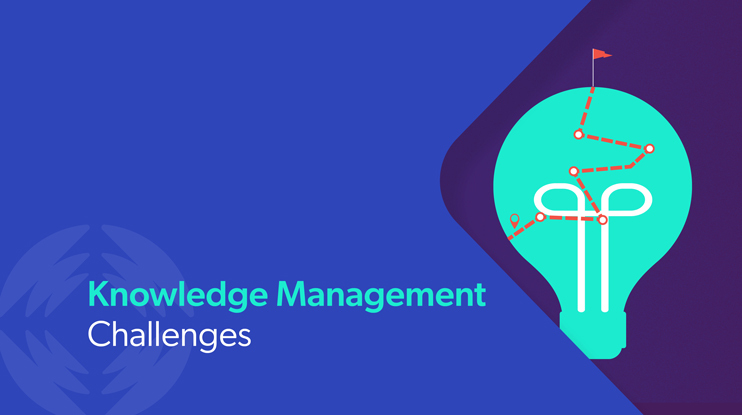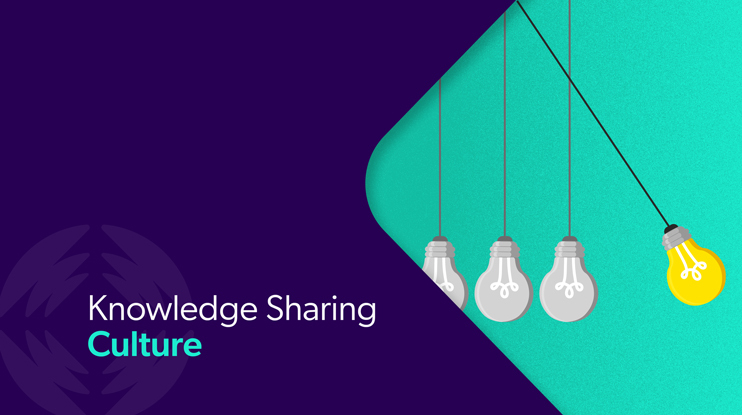Got knowledge management challenges?
If you’ve ever searched Google Drive for a document you’re sure is there but can’t remember the name, you do. If you remember saving an infographic on the company intranet but not exactly where, you do. Or if you’re using an instant messaging platform like Slack or Teams, you know there are reams of knowledge being created every day — but how do you ensure you’re using every relevant piece? Following this train of thought, knowledge management might seem like simply organizing a given knowledge base, right? Not really.
Today’s businesses operate in a knowledge economy powered by a wealth of information, interactions, and data. You need a comprehensive knowledge management system to connect your knowledge repository with the right people and eliminate the knowledge silos that can hinder your teams.
When done strategically, knowledge management can be the key to your organization’s efficiency, accuracy, and speed — both internally and for customer service functions.
In this article, we’ll cover the basics of an enterprise knowledge management strategy, the most common challenges, and how to overcome them. By the end, you’ll be set for a smooth transition to the next stage of enterprise knowledge management, no matter where you’re starting from.
Relevant Reading: 3 Ways GenAI Transforms Employee Experience
What Is Enterprise Knowledge Management?
Simply put, enterprise knowledge management (KM) is the ever-evolving act of developing, capturing, distributing, and using collective knowledge.
Importantly, it’s an approach to organizing business information that makes finding, accessing, and sharing knowledge easy. The most organized, logical knowledge base is useless if employees don’t know it’s available or how to use it. And let’s be honest – how many enterprises have just one knowledge base?
Knowledge sharing is a key outcome of strategic knowledge management, empowering the self-service success of customers and employees. It simplifies the process of knowledge transfer and allows information to be accessed by anyone who needs it.
At Coveo, we use the Technology & Services Industry Association’s (TSIA) four pillars: corporate culture, people, process, and technology. Each pillar must be integrated for an efficient and successful knowledge management program.
Think of them not quite as sequential steps, but as an iterative process:
- Corporate Culture: These are underlying beliefs, values, and assumptions of those within your organization.
- People: Your stakeholders, champions of and potential opposition to change.
- Process: Management and information system, governance frameworks, and best practices.
- Technology: Hardware, software, information technology infrastructure, and so on.
Effective Enterprise Knowledge Management Requires Introspection
When launching a new knowledge management initiative, start by determining the level and quality of your existing KM system. The TSIA Enterprise Knowledge Management Maturity Model can help you assess the maturity of your current knowledge management practice based on the four pillars. Use it to guide internal conversations around next steps for improvement.
A common fatal flaw in successfully operationalizing knowledge management efforts is in assuming there is one single destination or ideal metric to reach. Benchmarking the process is useful, but don’t get bogged down by just following what works for other organizations. Your path is as unique as the data you’re working with, and the process is ongoing.
As soon as you have a system up and running, start measuring and actioning insights as soon as possible. If your efforts result in tangible benefits, keep doing what you’re doing, and look for additional areas of impact to pursue.
Relevant Reading: 5 Best Practices for Multichannel Knowledge Management
Bringing Artificial Intelligence into the Picture
AI is making its way into almost every facet of business with most leaders expecting it to positively impact their organization. Search is one area where it can play a significant role. With legacy systems, search results are siloed and homogeneous. That is, they aren’t customized based on the user.
Without AI-driven personalizations, everyone, whether they’re a customer, an internal sales agent, or your HR director, gets the same result when they enter a search query. This also presumes your searcher knows where to look.
With an AI search platform like Coveo, search results are centralized and curated for the user (with security and source permissions accounted for). Content recommendations are based on factors like personal profile, common searched terms, and geolocation to surface the most relevant information.
AI-personalized search helps customers find answers faster. When they do need to reach out to knowledge workers like service agents, the search platform helps there, too. This happens through speeding up first contact resolution and lowering case counts. And it’s something customer-facing employees want to see in their workplace.
According to our recent EX Industry Report, 52% of field support employees desire to use AI-powered search tools to better serve customers and prospects. And all of the employees surveyed saw value in using generative tools to surface important documents faster and to personalize their intranets with tailored knowledge recommendations.
Notably, Salesforce has found that agents using Coveo AI search technology find the answer they’re looking for 75% of the time.
And answers can extend within the enterprise, as well. With the help of AI, employers can provide a self-service portal, internal help desk forms, and even chatbots — reducing the need to contact the IT team.
Relevant reading: See How Much AI Can Save You in Support Costs
5 Enterprise Knowledge Management Challenges (& Their Solutions)
1. Obsolete Technology
If you’re gathering knowledge but it’s not being shared widely or efficiently, you’re missing out on value.
Unfortunately, older systems usually rely on a decentralized architecture, where content is kept in various siloed repositories. Even if you already have a wealth of internal knowledge within reach, it’s probably insufficiently indexed for company-wide search.
Departments and teams tend to find their own preferred methods for data sharing and storing, such as Google Drives, Dropbox, or even just their Outlook email archives. Not to mention their own file naming convention, taxonomy, and more. This can feel more convenient within teams, but quickly becomes frustrating when collaborating with other departments. It can also prevent you from knowing who has the best solution to your question.
AI search layered into existing knowledge management systems ensures that indexed data is searchable and accessible. And the best part is that you don’t need to start from scratch. Even if your existing data is messy or badly structured, an AI-driven system like Coveo can integrate with legacy systems and map metadata fields by indexing the content and delivering it elsewhere.
There’ll be no disruption to existing knowledge sharing habits. Your employees (or customers) can use smart search without noticing the difference — other than a more efficient experience. Best of all, they won’t need to memorize a new host of search terms or jump words since AI can deliver relevant results from any indexed content source.
This is because as search interaction data is collected, AI will learn which synonyms or typos can be associated with certain content. This advanced machine learning aids in knowledge exchange and provides a better overall employee and customer experience with personalized, relevant results.
And when we say relevant search results, we really mean it. AI has evolved content discovery beyond creating user segments to deliver a more precise and scalable knowledge management solution. Instead of digging through pages of results, users will receive personalized search results based on their profiles, past search history, and more.
2. Lack of Employee Buy-in
According to Harvard Business Review (HBR), digital transformation initiatives fail, on average, 87.5% of the time. One of the main reasons for this is senior leadership’s failure to account for – and support – the employee learning curve. This lack of support creates a lack of employee buy-in for new technology.
Achieving efficient knowledge management means seeing what works and what doesn’t. Your platform needs search data to learn and grow. Without employee use, it will not perform to its potential. But it’s important to have realistic expectations about the time it takes for employees to learn a new system. Technology fatigue is a common challenge according to Deloitte studies, especially for adults ages 18-40. To employees, a new knowledge management process may feel like just another platform they need to learn, leading to low adoption and morale.
Choosing the right technology is key to the success of any digital change initiative. Using technology that integrates with your existing tech stack and introducing changes gradually can significantly increase adoption of new processes. For example, a platform like Coveo layers with content sources staff already use — meaning knowledge can be brought right into their flow of work.
Finally, use data to your advantage. Monitor KM analytics and customer service KPIs like case solve times or search result speed and accuracy. You might be surprised how quickly employees will take up the new system once they realize how much easier it makes their daily work.
3. Lack of Leadership Buy-in
Before you can work on employee participation, you’ll need management to support and drive the knowledge management initiative. There should be one, key person spearheading the change, supported by senior leadership and managers who will champion the project in their respective departments.
According to Deloitte, while 75% of surveyed organizations think creating and preserving organizational knowledge is important, only 9% said they were equipped to address this goal in any meaningful way.
You can make the shift to more effective knowledge management by leaning on “knowledge champions” to drive excitement. Have managers encourage knowledge sharing within and across business units and create processes and procedures to facilitate unselfish knowledge creation.
By making it every manager’s responsibility to support their team through changes around knowledge capture and sharing, you help ensure the successful adoption of new knowledge management practices.
4. Creating Consistent Organizational Change
Knowledge management is all about getting existing knowledge out of people’s heads and into a content format that’s accessible to those who need it. But how can you consistently build this process into everyday life at your organization? How do you ensure your plan aligns with your business goals?
Try Knowledge Centered Service, or KCS, a way of integrating knowledge sharing into the service process.
KCS is based on the idea that you should solve a customer problem once and share the solution as often as there is a demand for it. This approach allows you to realize huge gains in operational efficiency, employee morale, and customer satisfaction. How do you do it? Follow these steps:
- Set your goals
- Determine your process
- Make it easy for your team
- Set up your knowledge service software
- Train your team
A good knowledge management strategy can extend organizational knowledge to many customer-facing channels including chatbots, in-product support, and customer communities. The area you choose to focus on first should be directed by your company’s priorities.
Don’t wait to construct a “perfect” knowledge management process before you start putting critical knowledge into the hands of customers and agents. Knowledge distribution and use show you what works and where the knowledge gaps are, so getting started should be the top priority, even if there are still processes left to work out.
Shared leadership of knowledge centered service ensures that it becomes a best practice across your organization. Building this knowledge sharing culture will give you a competitive advantage when it comes to delivering exceptional service and your team will be delighted to have a fast, relevant search engine at their fingertips.
Relevant reading: Is Knowledge Centered Service Right for My Organization?
5. Making Current Information Easy to Find
If your customer service agents are accustomed to a knowledge management tool that’s clunky or unreliable, they are probably using tacit knowledge (that is, information in their head) over explicit knowledge (aka, information available for sharing).
Unfortunately, this creates problems when it comes to providing consistent information to customers. And according to Intercom’s Customer Service Report 2024, 87% of support teams in 2024 say customer service expectations have increased in the past year, now requiring an effective blend of AI and human support. This means it’s important now, more than ever, to create a knowledge management system that provides the most up-to-date info exactly when it’s needed in order to meet customer demands.
Having streamlined collaboration where everyone uses the same knowledge contribution platform will help achieve this goal, but you’ll need to help users understand that your new system is the quickest way to find relevant, up-to-date information.
And if the information can’t be found, its vital to make it easy for users to create and index new articles for the knowledge base. Search isn’t a magic wand for badly structured source data. But with good tools and smart strategy, the problem of outdated or unfindable information can be overcome. AI-powered search is your hero here. Prioritize bridging knowledge gap issues by serving the right information at the right time with tools like generative AI, and both your customer support team and your customers will have better experiences.
Bringing It All Together
Making valuable knowledge accessible is an organizational problem, not a departmental one. Keep your eye on the four pillars of knowledge management: organizational culture, people, process, and technology.
Focus on creating a search experience that works for customers and users, and deploy it everywhere for a seamless experience. They’ll be thrilled by your new, fast, and relevant search tool.
Ready to learn more about the Coveo Platform™? Request a personalized demo today.
Dig Deeper
Looking for a real-world example of an organization that used AI-powered search to overcome their knowledge management challenges? Read Manulife’s story, and learn how AI-powered search enabled them to connect different knowledge repositories and create an intelligent backbone of information available to all employees.






